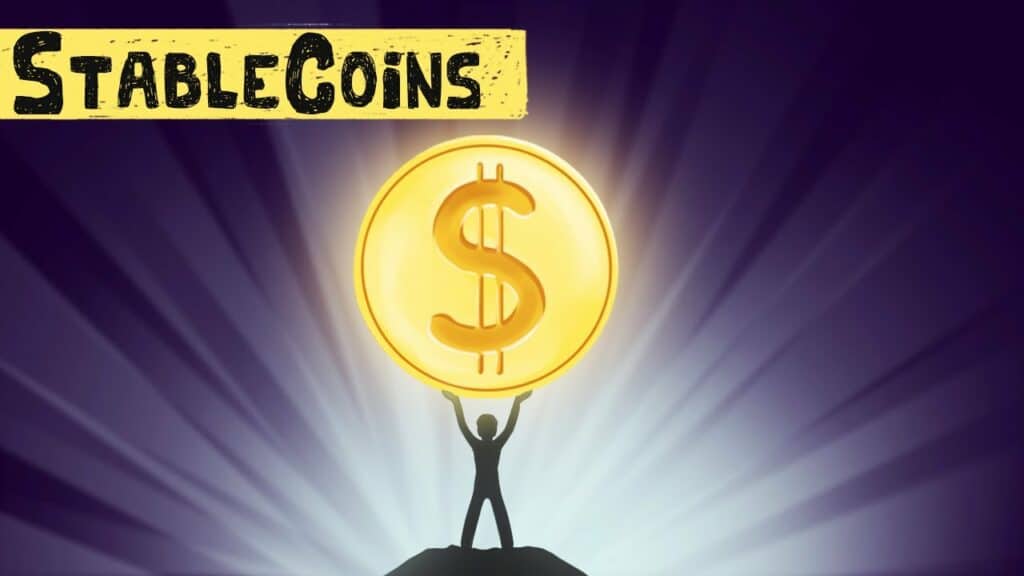What if there was a way you could buy a cryptocurrency that was basically cash, it didn’t change value, but it still was transferable and tradable as a crypto?
No more days of panicking and seeing an Elon Musk tweet pumping and dumping his coin of choice. No more wondering if you lost your grandpa’s pension funds that you had invested.
While that sounds juicy, we want to say that this article was made for education and entertainment purposes. Anything you do outside of this video is on you. We just want to be able to help you make the most educated decisions.
So today we want to explain what stablecoins are and how you can best use them to leverage your crypto trades.
What Exactly is a Stablecoin?

A stablecoin is technically a utility token built upon another coin’s blockchain.
If you don’t know the differences between tokens and coins you can check out our article on that topic as well. But the entire goal of a stablecoin is to create a cryptocurrency that isn’t volatile and doesn’t change price.
Stablecoins try to offer the best of both worlds of cryptocurrencies and fiat. They offer the convenience, privacy, and security of crypto, while offering the stability and trust of fiat money.
A stablecoin is pegged to the US dollar—or other fiat currency—and will always equal $1. Theoretically.
Bitcoin, the first cryptocurrency, was actually created to be used as a store of value. However, since it’s not widely adopted and there aren’t many regulations on it yet, the price fluctuates a lot—so much so that it is classified as a speculative investment.
So what if you want to store money using crypto technology, but don’t want to risk your investment with the price fluctuations of crypto? Use a trusted stablecoin.
Before we get too deep into stablecoins, you first need a refresher on the differences between a centralized exchange and a decentralized exchange.
Centralized Exchange
A centralized exchange is an exchange that is owned by one entity, like Coinbase, but allows you to buy and sell cryptocurrencies.
Since they are a company, they are technically regulated by the government that manages the jurisdiction where the company is based.
Decentralized Exchange
A decentralized exchange is an exchange that isn’t run by a company, instead they are run by code. Changes to the exchange only happen when the code is changed.
Due to their decentralized nature, a government can’t regulate, control, or shut them down like they could Coinbase.
Using stablecoins, you can trade back and forth between ETH, a stablecoin, and BTC, whenever you want using a decentralized exchange. This way you don’t have to pay as many fees, wait as long, or worry about a government tracking your transactions as you would when you use a centralized exchange.
This is a good advantage of stablecoins. Say you purchase 100 bitcoins for $100. Bitcoin then goes up to 10k per coin, so you sell 50 bitcoins for 500k of DAI or USDC and then hold it for a dip when you can decide if you want to buy it back, almost like a crypto savings account.
Stablecoins are also beneficial when investing on platforms like AAVE, where you can earn interest on your crypto assets, because you don’t have to worry about price fluctuations. 20% APR on ETH doesn’t matter if ETH drops by half. However 20% APR on your USDC stablecoin is delicious.
How Stablecoins Work
Stablecoins work in two different ways: through collateralization or algorithmic mechanisms aka smart contract manipulation.
1. Collateralization
Fiat collateralization means that each coin is backed by something. In most cases, that is one US dollar. In some though, it’s other countries currencies (like the euro) or even gold.
Tether is one major company that released their USDT stablecoin using fiat collateralization. There are some rumors they don’t have a dollar for every USDT, though.
The pros of a fiat-collateralized stablecoin is that they are quite stable, much more than the alternatives.
However, they do have problems. The first is that the money required to put up for each USDT can’t be invested. This could be millions of dollars that aren’t earning interest. Another problem is that someone at the company could embezzle or steal a bunch of the collateral.
One last problem, specifically that Tether faces, is that it is difficult to prove that you own the total amount of collateral.
Some stablecoins are collateralized with other crypto assets instead of fiat. This is of course problematic because of the inconsistent nature of cryptocurrency prices, but it’s easier to prove the reserves because anyone can see the blockchain.
2. Smart Contracts
As an alternative to the fiat collateralization method, some stablecoins are controlled by a smart contract. Some people call this algorithmically pegged stablecoins.
The benefit of this method is that it is very easy to audit—you just take a look at the smart contract code. Another benefit is that there are no physical assets to steal.
However, some of the problems can seem much worse. Smart contract controlled stablecoins are usually much more volatile simply due to how they work. Smart Contracts must manipulate the supply of their coins to adjust the price.
The algorithm differs among each stablecoin, but there are three main algorithms. One changes the amount of the coin in your wallet so the value stays the same. Another uses a money printer and a bond reward system to adjust the price to $1. A third is very similar, however uses coupons instead.
These are considered more risky stablecoins.
How to Buy a Stablecoin
Stablecoins are bought and sold on exchanges, both centralized and decentralized. It’s very easy to buy Tether, Dai, or USDC on Coinbase or Gemini.
You can also buy something like ETH on Coinbase, transfer it to your wallet, and then use a decentralized exchange like Uniswap to trade that ETH to a stablecoin.
If you’re wanting to learn how to earn a much higher interest rate than what most banks can currently afford, we recommend lending out your stablecoins.
Lending your crypto to a place like AAVE or Curve can easily earn you 10-20% APR in the current crypto atmosphere.
Some Issues with Stablecoins
Alright, now it’s time to be a little more pessimistic around the topic of stablecoins.
While stablecoins do have good traits around them there are a few things that you should think about before fully ditching your savings account and tossing all your savings into a stablecoin.
1. Lack of Insurance
When you put your money in a savings or checking account it is insured by the government. Some banks are FDIC insured which means they’ll repay up to $250,000 worth of money that is stolen or lost from them to you.
Stablecoins do not have this advantage yet. If a company that started and is operating that stablecoin goes bankrupt, then you lose all of your investment and will be left empty-handed.
2. Collateralization Issues
Remember how we said there were rumors that Tether may not actually be backed by true cash? If they aren’t—and that scares people—the price could fluctuate a lot, even cause it to be unpegged to a dollar.
Why? Because Tether is only worth what people think it is worth, and right now that is $1. If that belief changes, then the value changes.
We just finished up a whole article about Tether’s collateralization issues if you want to read more up on it!
Conclusion
Coming to a conclusion, stablecoins are a great advancement for crypto at the current moment and we’re excited to see where they go in the future. If you’re going to put your money into them we would be cautious and as always, recommend doing your own research.
As we end this article, we want to thank you for watching this video. We hope you enjoyed it, we really hope you learned something, and most importantly we hope to see you next time.

